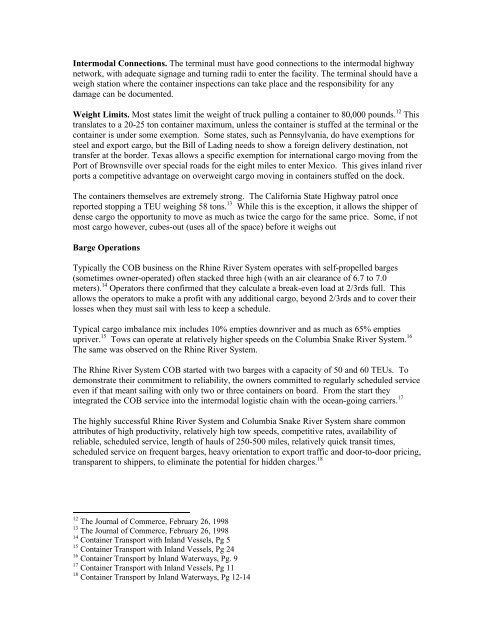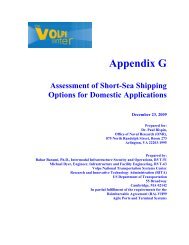Container-on-Barge Pre-Feasibility Study Final Report - Towmasters ...
Container-on-Barge Pre-Feasibility Study Final Report - Towmasters ...
Container-on-Barge Pre-Feasibility Study Final Report - Towmasters ...
Create successful ePaper yourself
Turn your PDF publications into a flip-book with our unique Google optimized e-Paper software.
Intermodal C<strong>on</strong>necti<strong>on</strong>s. The terminal must have good c<strong>on</strong>necti<strong>on</strong>s to the intermodal highway<br />
network, with adequate signage and turning radii to enter the facility. The terminal should have a<br />
weigh stati<strong>on</strong> where the c<strong>on</strong>tainer inspecti<strong>on</strong>s can take place and the resp<strong>on</strong>sibility for any<br />
damage can be documented.<br />
Weight Limits. Most states limit the weight of truck pulling a c<strong>on</strong>tainer to 80,000 pounds. 12 This<br />
translates to a 20-25 t<strong>on</strong> c<strong>on</strong>tainer maximum, unless the c<strong>on</strong>tainer is stuffed at the terminal or the<br />
c<strong>on</strong>tainer is under some exempti<strong>on</strong>. Some states, such as Pennsylvania, do have exempti<strong>on</strong>s for<br />
steel and export cargo, but the Bill of Lading needs to show a foreign delivery destinati<strong>on</strong>, not<br />
transfer at the border. Texas allows a specific exempti<strong>on</strong> for internati<strong>on</strong>al cargo moving from the<br />
Port of Brownsville over special roads for the eight miles to enter Mexico. This gives inland river<br />
ports a competitive advantage <strong>on</strong> overweight cargo moving in c<strong>on</strong>tainers stuffed <strong>on</strong> the dock.<br />
The c<strong>on</strong>tainers themselves are extremely str<strong>on</strong>g. The California State Highway patrol <strong>on</strong>ce<br />
reported stopping a TEU weighing 58 t<strong>on</strong>s. 13 While this is the excepti<strong>on</strong>, it allows the shipper of<br />
dense cargo the opportunity to move as much as twice the cargo for the same price. Some, if not<br />
most cargo however, cubes-out (uses all of the space) before it weighs out<br />
<strong>Barge</strong> Operati<strong>on</strong>s<br />
Typically the COB business <strong>on</strong> the Rhine River System operates with self-propelled barges<br />
(sometimes owner-operated) often stacked three high (with an air clearance of 6.7 to 7.0<br />
meters). 14 Operators there c<strong>on</strong>firmed that they calculate a break-even load at 2/3rds full. This<br />
allows the operators to make a profit with any additi<strong>on</strong>al cargo, bey<strong>on</strong>d 2/3rds and to cover their<br />
losses when they must sail with less to keep a schedule.<br />
Typical cargo imbalance mix includes 10% empties downriver and as much as 65% empties<br />
upriver. 15 Tows can operate at relatively higher speeds <strong>on</strong> the Columbia Snake River System. 16<br />
The same was observed <strong>on</strong> the Rhine River System.<br />
The Rhine River System COB started with two barges with a capacity of 50 and 60 TEUs. To<br />
dem<strong>on</strong>strate their commitment to reliability, the owners committed to regularly scheduled service<br />
even if that meant sailing with <strong>on</strong>ly two or three c<strong>on</strong>tainers <strong>on</strong> board. From the start they<br />
integrated the COB service into the intermodal logistic chain with the ocean-going carriers. 17<br />
The highly successful Rhine River System and Columbia Snake River System share comm<strong>on</strong><br />
attributes of high productivity, relatively high tow speeds, competitive rates, availability of<br />
reliable, scheduled service, length of hauls of 250-500 miles, relatively quick transit times,<br />
scheduled service <strong>on</strong> frequent barges, heavy orientati<strong>on</strong> to export traffic and door-to-door pricing,<br />
transparent to shippers, to eliminate the potential for hidden charges. 18<br />
12 The Journal of Commerce, February 26, 1998<br />
13 The Journal of Commerce, February 26, 1998<br />
14 <str<strong>on</strong>g>C<strong>on</strong>tainer</str<strong>on</strong>g> Transport with Inland Vessels, Pg 5<br />
15 <str<strong>on</strong>g>C<strong>on</strong>tainer</str<strong>on</strong>g> Transport with Inland Vessels, Pg 24<br />
16 <str<strong>on</strong>g>C<strong>on</strong>tainer</str<strong>on</strong>g> Transport by Inland Waterways, Pg. 9<br />
17 <str<strong>on</strong>g>C<strong>on</strong>tainer</str<strong>on</strong>g> Transport with Inland Vessels, Pg 11<br />
18 <str<strong>on</strong>g>C<strong>on</strong>tainer</str<strong>on</strong>g> Transport by Inland Waterways, Pg 12-14
















